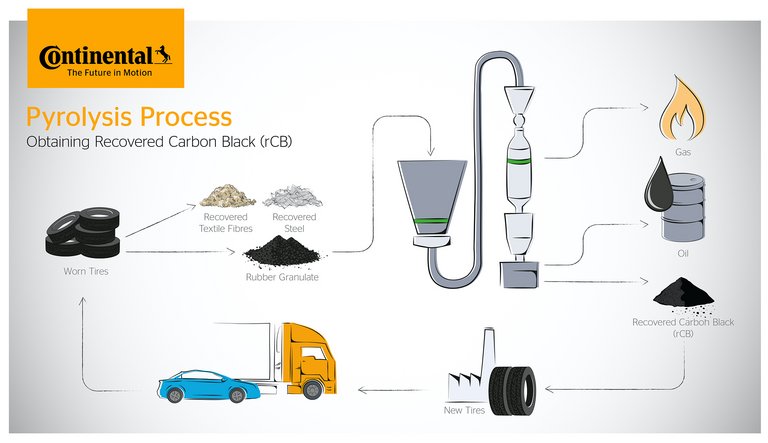Car tires are round, black and made of rubber. Look closer, however, and you’ll see that the design of tires and the interaction of the various materials that go into making them are extremely complex. But for some time now, the material experts and tire engineers at Continental have been bringing about a silent revolution. By 2050 at the latest, all tires are to be made of sustainable materials. There is still a long way to go until then. But step by step, it is already becoming apparent which raw materials will find their way into tire construction in the future. These include waste products from agriculture – such as the ash from rice husks – rubber from dandelions, recycled rubber or PET bottles.
Claus Petschick, Head of Sustainability at Continental Tires, is clear about Continental’s mission, saying, “Continental is on the road toward becoming the most progressive manufacturer in the tire industry in terms of sustainability. We aim to use 100 percent sustainable materials in our tire products by 2050 at the latest.” He adds, “Our innovative power enables us to break new and even more sustainable ground. This encompasses everything from the origin and sourcing of our materials through to the reuse and recycling of our tires.”
Already today, around 15 to 20 percent renewable or recycled materials are used in a standard passenger car tire from Continental. To further increase the proportion of sustainable materials and conserve valuable resources, Continental continuously analyzes and reviews all raw materials used in tire production.
Perfect material matching for maximum safety
Depending on the application, season and environment, tires have to fulfill specific requirements. This can be seen in, for example, the tread design. But in other areas – the composition of the rubber compound, for example – these changes are not so readily visible.Passenger car tires from Continental consist of as many as a hundred different raw materials.
Their precise composition has a major impact on the tires and their handling characteristics. The ability to deploy the various materials with their unique properties and interdependencies in specific ways is a complex balancing act for Continental’s engineers and material experts. Only when all the materials are ideally matched to each other can safe, energy-efficient and durable high-performance tires be created.
Natural rubber still essential thanks to its exceptional properties
Natural rubber is essential for ensuring outstanding tire performance. This natural product accounts for between 10 and 40 percent of the entire weight of modern high-performance tires. Its special properties include the high level of strength and durability, which are caused by the strain-induced crystallization of the rubber. The tire industry is the biggest consumer of global rubber production, accounting for more than 70 percent. However, Continental considers natural rubber a sustainable material only if it is sourced responsibly. Therefore, the company employs an integrated approach aimed at making the complex and fragmented supply chains for natural rubber more sustainable. Including using cutting-edge digital technology, local involvement and close collaboration with capable partners with the goal of improving transparency and traceability along the entire value chain. Meanwhile, with its Taraxagum project, Continental is pursuing an innovative approach to ensure that it can become less dependent on natural rubber grown primarily in southeast Asia. The tire manufacturer is working alongside partners on industrializing the extraction of natural rubber from specially cultivated dandelion plants.
Sustainable plant-based fillers
In addition to rubber, fillers such as silica are essential to tire assembly. Silica, for example, helps to optimize characteristics such as grip, rolling resistance and tire life. In the future, rice husks will be used as the source material for sustainably produced silica. Rice husks are a waste product of rice production and cannot be used as food or animal feed. Silica derived from the ash of rice husks is more energy-efficient when used in manufacturing than that obtained from conventional materials such as quartz sand.
Plant-based oils – such as rapeseed oil and resins based on residual materials from the paper and wood industries – already offer an alternative to crude-oil-based fillers in Continental’s tires. Only oils that meet technical quality standards and are not suitable for consumption are used. Oils and resins allow for flexibility in terms of tire compounds and so improve the material’s grip.
Expanding the circular economy
Continental is aiming for fully circular operations in its tire production by 2050 at the latest. In addition to the use of renewable materials, the company is working systematically on using recycled raw materials in tire production. This is intended to ensure that carbon black – another crucial filler in rubber compounds – can be obtained on a large scale in the future. Continental recently signed a development agreement with Pyrum Innovations with a view to further optimizing the recycling of materials from old tires. To do this, Pyrum breaks the old tires down into their constituent parts in an industrial furnace using a special pyrolysis process. In this way, valuable raw materials contained in end-of-life tires can be extracted and recycled. Both companies are working towards obtaining high-quality raw materials from the pyrolysis oil obtained for Continental’s tire production in the medium term, in addition to the direct use of high-quality carbon black. In the long term, the premium tire manufacturer and Pyrum are aiming to establish a closed-loop circular economy concept for the recycling of old tires.

